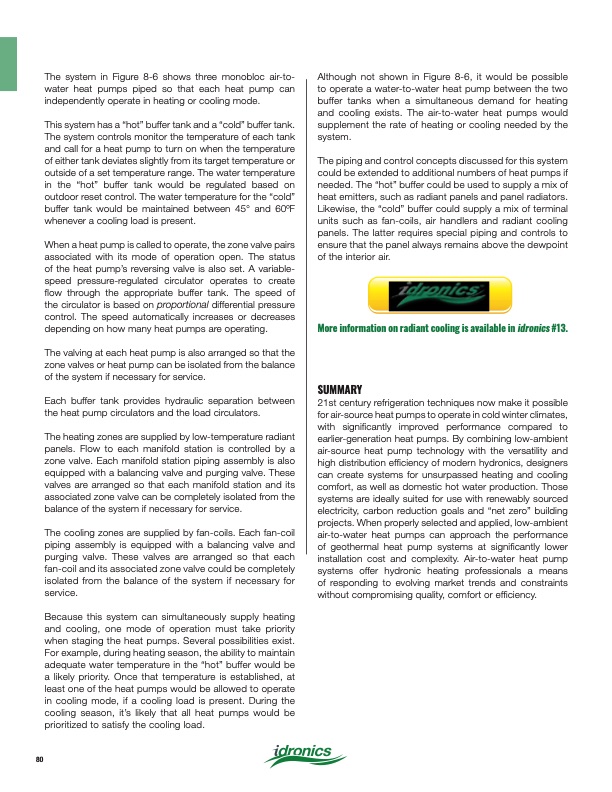
PDF Publication Title:
Text from PDF Page: 080
The system in Figure 8-6 shows three monobloc air-to- water heat pumps piped so that each heat pump can independently operate in heating or cooling mode. This system has a “hot” buffer tank and a “cold” buffer tank. The system controls monitor the temperature of each tank and call for a heat pump to turn on when the temperature of either tank deviates slightly from its target temperature or outside of a set temperature range. The water temperature in the “hot” buffer tank would be regulated based on outdoor reset control. The water temperature for the “cold” buffer tank would be maintained between 45° and 60oF whenever a cooling load is present. When a heat pump is called to operate, the zone valve pairs associated with its mode of operation open. The status of the heat pump’s reversing valve is also set. A variable- speed pressure-regulated circulator operates to create flow through the appropriate buffer tank. The speed of the circulator is based on proportional differential pressure control. The speed automatically increases or decreases depending on how many heat pumps are operating. The valving at each heat pump is also arranged so that the zone valves or heat pump can be isolated from the balance of the system if necessary for service. SUMMARY 21st century refrigeration techniques now make it possible for air-source heat pumps to operate in cold winter climates, with significantly improved performance compared to earlier-generation heat pumps. By combining low-ambient air-source heat pump technology with the versatility and high distribution efficiency of modern hydronics, designers can create systems for unsurpassed heating and cooling comfort, as well as domestic hot water production. Those systems are ideally suited for use with renewably sourced electricity, carbon reduction goals and “net zero” building projects. When properly selected and applied, low-ambient air-to-water heat pumps can approach the performance of geothermal heat pump systems at significantly lower installation cost and complexity. Air-to-water heat pump systems offer hydronic heating professionals a means of responding to evolving market trends and constraints without compromising quality, comfort or efficiency. Each buffer tank provides hydraulic separation between the heat pump circulators and the load circulators. The heating zones are supplied by low-temperature radiant panels. Flow to each manifold station is controlled by a zone valve. Each manifold station piping assembly is also equipped with a balancing valve and purging valve. These valves are arranged so that each manifold station and its associated zone valve can be completely isolated from the balance of the system if necessary for service. The cooling zones are supplied by fan-coils. Each fan-coil piping assembly is equipped with a balancing valve and purging valve. These valves are arranged so that each fan-coil and its associated zone valve could be completely isolated from the balance of the system if necessary for service. Because this system can simultaneously supply heating and cooling, one mode of operation must take priority when staging the heat pumps. Several possibilities exist. For example, during heating season, the ability to maintain adequate water temperature in the “hot” buffer would be a likely priority. Once that temperature is established, at least one of the heat pumps would be allowed to operate in cooling mode, if a cooling load is present. During the cooling season, it’s likely that all heat pumps would be prioritized to satisfy the cooling load. Although not shown in Figure 8-6, it would be possible to operate a water-to-water heat pump between the two buffer tanks when a simultaneous demand for heating and cooling exists. The air-to-water heat pumps would supplement the rate of heating or cooling needed by the system. The piping and control concepts discussed for this system could be extended to additional numbers of heat pumps if needed. The “hot” buffer could be used to supply a mix of heat emitters, such as radiant panels and panel radiators. Likewise, the “cold” buffer could supply a mix of terminal units such as fan-coils, air handlers and radiant cooling panels. The latter requires special piping and controls to ensure that the panel always remains above the dewpoint of the interior air. More information on radiant cooling is available in idronics #13. 80PDF Image | Heat Pump Systems 2020

PDF Search Title:
Heat Pump Systems 2020Original File Name Searched:
idronics_27_na.pdfDIY PDF Search: Google It | Yahoo | Bing
CO2 Organic Rankine Cycle Experimenter Platform The supercritical CO2 phase change system is both a heat pump and organic rankine cycle which can be used for those purposes and as a supercritical extractor for advanced subcritical and supercritical extraction technology. Uses include producing nanoparticles, precious metal CO2 extraction, lithium battery recycling, and other applications... More Info
Heat Pumps CO2 ORC Heat Pump System Platform More Info
| CONTACT TEL: 608-238-6001 Email: greg@infinityturbine.com | RSS | AMP |